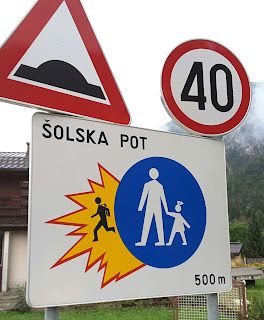The serenity of Mojstrana and Slovenia hides a dark time following WWII. While Googling "The history of Mojstrana", I stumbled onto some information about a mass grave near the village and other mass graves throughout Slovenia. A summary from the internet:
"Mass graves in Slovenia were created as a result of executions by anti-fascists during and after WWII. They are known as concealed or silenced mass graves because their existence was concealed under communist rule from 1945 to 1990. Nearly 600 such sites have been registered by a Slovenian Commission and contain remains of up to 100,000 victims.
"Mass graves in Slovenia were created as a result of executions by anti-fascists during and after WWII. They are known as concealed or silenced mass graves because their existence was concealed under communist rule from 1945 to 1990. Nearly 600 such sites have been registered by a Slovenian Commission and contain remains of up to 100,000 victims.
The larger mass grave sites date from after the war and include soldiers and groups that were targeted by anti-schists because of their ethnicity or political views.
The postwar graves contain the remains of suspected Nazi/fascist collaborators, German soldiers, and civilians who fled toward Austria in May and June of 1945 as well as groups targeted because of the ethnicity (Germans, Hungarians, and Italians) and civilians marked as political "class enemies" that might oppose the new post war regime.
After the war, the communists denied that the executions had taken place and attempts to reveal the executions were suppressed, evidence was destroyed, and no exhumations took place. People were forbidden from visiting the graves.
After the fall of communism and the collapse of Yugoslavia, researchers in Slovenia started writing about the executions and exhumations were undertaken. However, some left-wing parties, in particular the Social Democrats, have been accused of stalling the investigations."
.
The anit-fascists have long been considered heroes for their resistance to German and Italian occupation during the war, but their acts of retaliation after the war once more reveal the dark side of human nature.
.
The mass grave in Mojstrana is (according to the internet) in a forested area just south of the village. It contains 10 to 20 German soldiers and possibly several civilians. We went in search of it based on a topographical map posted on the internet with a circle denoting the exact location. There is no marker, so we had to depend on the map and the description of the area. If the circle noted on the map is correct, we either found the spot or came close. We found a path leading to an area with several white watermelon sized stones at the topo map location (no other stones were observed along the path).
.
The anit-fascists have long been considered heroes for their resistance to German and Italian occupation during the war, but their acts of retaliation after the war once more reveal the dark side of human nature.
.
The mass grave in Mojstrana is (according to the internet) in a forested area just south of the village. It contains 10 to 20 German soldiers and possibly several civilians. We went in search of it based on a topographical map posted on the internet with a circle denoting the exact location. There is no marker, so we had to depend on the map and the description of the area. If the circle noted on the map is correct, we either found the spot or came close. We found a path leading to an area with several white watermelon sized stones at the topo map location (no other stones were observed along the path).
Some of the stones arranged in a crude rectangle that
possibly mark the site of the mass grave near Mojstrana.
Rain soon forced us back inside but it stopped in the late afternoon, so we took a walk through the village. Some of the views of Mojstrana.
Entrance to the village grocery store.
The village park.
From a footbridge that crosses the valley river
on the north side of the village.
One of the newer homes in the village.
A home for sale in the village.
Soccer field.
The sign says School Way (Solska Pot)
and indicates 40 km/hr (25 mph) and a speed bump
A road sign in the village showing
which road to take for various towns
A sign at a fork in the village.
Sola = School
Slap = Waterfall
Dolina = Valley
muzej = museum
dom = home
The stream that runs through the village.
The building with our accommodations
is around the bend on the left side.
Other misc views from Mojstrana and Dovje.
An ice climbing wall on the south side of the village
(the water fall forms the ice in winter and the
ropes are attached to harnesses on the ice climbers)
Picture on a building beside
the ice climbing wall.
Pictures on a building from Christmas events
held near the ice climbing wall.
Both villages are a mix of old and new.
A building wall on the road through Mojstrana.
Along a narrow street through Dovje.



















